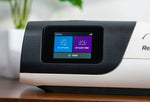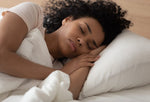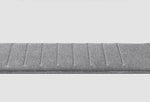- Tracks sleep stages, sleep score, snoring, heart rate, and breathing
- Works without you wearing anything
- Price is less than or comparable to most sleep-tracking wearables
- Can share sleep diary and health report directly with your doctor
- Connects with smart home lights and thermostats to automatically prepare your sleep environment
- Connects with other health tracking apps to provide more complete picture of overall health data
On This Page
Withings Sleep Tracking Mat Review
Our editorial process includes extensive measures to verify accuracy, provide clarity on complex topics, and present factual information. Read more

Who Is the Withings Sleep Tracking Mat Best For?
The Withings Sleep tracking mat is a good option if you want to track your sleep and health data each night, but you don’t want to wear your sleep tracker. Once the Withings Sleep is set up, it tracks your data automatically each time you sleep. It’s also surprisingly accurate given it doesn’t make contact with your skin. The mat can also connect with smart home devices, making it a good choice if you want your bedroom lights and room temperature automatically adjusted for sleep as soon as you get into bed.
Withings Mat Pros and Cons
Pros
Cons
- Needs to plug into an outlet, which could be inconvenient in some bedrooms
- Challenging to set up, as you have to lift your mattress to get into place
- May not be ideal for frequent travelers, since it’s larger than a wearable and must go under a mattress
- Provides data that may suggest you have symptoms of sleep apnea, but cannot positively identify sleep apnea without a different, more detailed sleep test
How Does the Withings Sleep Tracking Mat Work?
The Withings Sleep is an ultra-thin smart mat that sits beneath your mattress and collects your sleep and health data. Once you’ve installed the Withings Sleep tracking mat by placing it under the mattress, you plug its power cable into an electrical outlet. Then, the mat uses smart tech to collect data and compile it into reports about your sleep and health.
While the installation instructions are simple, keep in mind that you’ll need to lift one side of your mattress, while also sliding the mat in place under where your chest would be when sleeping. This is definitely a two-person job in most cases. If you have a platform bed, this is much simpler. If you have a bed frame with slats, you’ll need to place something flat – like a piece of plywood or cardboard – on top of the slats to ensure proper operation.
The Withings Sleep tracking mat connects to your phone or tablet via Bluetooth. You can view all of your Withings Sleep data in a free app by Withings called Health Mate, which is compatible with iOS and Android systems. The Withings Health Mate app can also integrate with Apple Health and over 100 other health-related apps. Additionally, you can have the Withings Health Mate app create both a sleep diary and health report and share them with your doctor, which may help them better understand your sleep patterns and overall health.
Finally, the Withings Sleep tracking mat can integrate with your smart home devices and automatically adjust your lighting and thermostat when you get in or out of bed. This feature helps prepare your environment for sleep without requiring effort on your part.
Standout Features of the Withings Mat
I found that data from the Withings Sleep closely aligned with data from the Whoop strap measurements (I’ve worn one for two years now), which surprised me given I wear the Whoop band around my wrist, and the Withings Mat is under a 14” mattress. Everything from heart rate to sleep cycle measurements was right in line. As a pure sleep tracker, the Withings Mat will more than do the job.
I was also happy to find that the Withings Health Mate app integrates with the Apple Health app. My Whoop also feeds into Apple Health, so between the two I got a surprisingly good view of my overall activity and health.
What Data Does the Withings Sleep Tracking Mat Track?
The Withings Sleep tracking mat collects data on:
- Your heart rate
- Your breathing rate
- If and when you snore
Withings then immediately processes this data using exclusive algorithms developed by sleep doctors and researchers in order to provide you useful measures about your sleep and health.
The sleep data Withings Sleep provides you through the Health Mate app include:
- How long it takes you to fall asleep
- How long you are asleep for
- How many times you wake up
- How regular your sleep schedule is
- How much time you spend in light sleep, deep sleep, and rapid eye movement (REM) sleep stages
- How many times and for how long you snore
All of this data is compiled into a nightly sleep score to give you an overall idea of how well you sleep.
The Withings Sleep tracking mat also provides your average heart rate during sleep, as well as your highest and lowest heart rates during sleep.
How Does the Withings Sleep Detect Sleep?
The Withings Sleep tracking mat detects sleep using two types of sensors: pneumatic and sound sensors. Pneumatic sensors comprise a bladder full of air that senses changes in air pressure. Pneumatic sensors collect data on body movements, heart rate, and breathing. Sound sensors pick up audio signals and collect data on snoring and breathing.
As the Withings Sleep tracking mat collects data using pneumatic and sound sensors, its expert-created algorithms use this data to determine when a person has fallen asleep. Additionally, the tracking mat data and algorithms can estimate what sleep stage a person is in while they are asleep, as well as when they wake up during the night, even if they don’t get out of bed.
How Does the Withings Sleep Measure Deep Sleep?
The Withings Sleep identifies sleep stages, including deep sleep, through a combination of its pneumatic sensors and proprietary algorithms. Deep sleep is a restorative stage of sleep most common during the first few hours after a person has fallen asleep. Generally, there’s a drop in body movements and breathing speed during this stage of sleep.
How Does the Withings Sleep Measure Heart Rate?
The pneumatic sensors within the Withings Sleep measure heart rate using a method called ballistocardiography. Pneumatic sensors involve air-filled bladders that sense changes in pressure. These sensors identify what are called ballistic forces created by the heart, or movement and pressure created as blood moves through parts of the heart.
History of the Withings Sleep Tracking Mat
The earliest version of the Withings Sleep tracking mat first came onto the market in 2018 under the name Nokia Sleep. Later that year, Nokia sold its line of health devices to the Withings company, and the tracking mat was then called Withings Sleep. While the early device looked very similar to how it looks now, the mat did not yet track breathing interruptions and the data it provided wasn’t as accurate as the data provided currently.
Can the Withings Sleep Tracking Mat Detect Sleep Apnea?

The Withings Sleep, which is a sleep tracking mat sold in the US, cannot detect sleep apnea.
However, the Withings Sleep Analyzer, which is a tracking mat made by the same company and sold in Europe, can detect sleep apnea. The Withings Sleep Analyzer sold in Europe can also identify if a person’s sleep apnea is considered mild, moderate, or severe. Currently, the Withings Sleep Analyzer isn’t available for sale in the US or approved by the Food and Drug Administration (FDA).
Although the Withings Sleep tracking mat sold in the US cannot detect sleep apnea, its features may still be useful to sleepers who are concerned about whether or not they have the disorder. The Withings Sleep tracks snoring and breathing interruptions, which are common symptoms of sleep apnea. The mat also tracks awakenings during the night, and people with sleep apnea tend to wake up from sleep more often.
If you suspect you may have sleep apnea, see your doctor and share your symptoms with them. If you’re using the Withings Sleep to track your sleep and health data, consider sending your doctor your Withings-generated sleep diary or health report. They may use the data you share to help determine whether or not to order a sleep study for you.
At this point in time, doctors can only diagnose you with sleep apnea using a sleep study or home sleep apnea test (HSAT). You cannot use your Withings Sleep or other sleep tracking tools to provide an official diagnosis.
How Accurate Is the Withings Sleep Tracking Mat?
Some independent research studies have examined the accuracy of the Withings Sleep tracking mat and found positive results. One study published in 2024 determined that the Withings Sleep tracking mat could identify overall sleep time, as well as deep and REM sleep stages, with high accuracy. The types of slight errors the Withings Sleep tracking mat made were comparable to slight errors made by other sleep tracking tools, like Fitbit devices and the Oura Ring.
Another study found that the Withings Sleep tracking mat performed with similar accuracy to Fitbit devices. However, these different tools produced slight errors in different directions among people with sleep problems. For example, the Withings Sleep tracking mat overestimated time spent in deep sleep, while Fitbit devices underestimated time spent in deep sleep.
If you use multiple sleep tracking tools and notice discrepancies, the direction in which they make slight errors might explain it. The authors of this study conclude that commercially available sleep tracking tools shouldn’t be used to diagnose sleep apnea because of these discrepancies.
How to Install the Withings Sleep Tracking Mat
If you purchase the Withings Sleep tracking mat, here are instructions for opening and installing it.
- Open the box carefully. If you use a knife or razor to cut tape on the box, take care not to cut too deeply into the box where you might damage the mat.
- Remove the sleep sensor mat and the USB power adaptor from their packaging.
- Place the entire sleep sensor mat on a flat surface under your mattress horizontally, so it will sit directly beneath your chest as you sleep. Note that you may need another person to help you with this step by lifting the mattress. If you have a mattress topper, you may place the Withings Sleep between your mattress and the topper. If you sleep alone, center the mat beneath the center of the bed. If you sleep with a partner, put the mat closer to your side of the bed.
- Once the sensor mat is beneath the mattress and the mattress is back in place, make sure only the cord is sticking out and none of the mat is visible. The cord coming out of the mat ends in a USB plug. Put that plug into the hole on the USB power adaptor. Then, plug the USB power adaptor into the nearest electrical outlet. The mat must remain plugged-in to work.
- From your smartphone or tablet, visit go.withings.com. From there, follow instructions to install the Health Mate app onto your device.
- Once you’ve downloaded the Health Mate app, open it. Follow instructions within the app to connect your Withings Sleep device. Once you’ve followed set-up instructions in the app, you can check the app each day to access your sleep data.
If you’d like to connect your Withings Health Mate app with other health apps, follow the instructions outlined on the Withings Tutorials web page for the specific app you want to integrate.
Where Should the Withings Sleep Tracking Mat Be Placed?
The Withings Sleep tracking mat should be placed beneath your mattress, on top of a flat surface your mattress sits on. Arrange the mat horizontally, so the longer side of the mat is perpendicular to the longer side of your bed. Place the tracking mat on the upper portion of the bed, so it will sit beneath your chest as you sleep.
The Withings Sleep is specifically designed to work best while sitting on a flat surface. Both a platform bed and box springs are examples of flat surfaces that the Withings Sleep works well on. If your mattress is on top of a slatted surface, put plywood or stiff cardboard below the sleep tracking mat beneath your mattress, so your Withings will work optimally.
How to Reset the Withings Sleep Tracking Mat
People may want to reset their Withings Sleep to remove data from it before returning it or giving it to someone else. You can perform a factory reset on your Withings Sleep by following these steps:
- Access the Settings of the mobile device you use to check your Withings Health Mate app. Select Bluetooth, then “forget” or “remove” the device from your Bluetooth list, so it will no longer pair with your device.
- Remove the Withings Sleep from beneath your mattress. Remove the inner part of the mat from its fabric cover.
- Unplug the Withings Sleep from the electrical outlet, then plug it back in again.
- Flip the device over, then push the Reset button. Hold it for five seconds, until the LED on the back of the device flashes red three times, then flashes green, then blue. Once it flashes blue, you know you’ve reset the device successfully.
When you reset your Withings Sleep, you remove all data saved on the device. You do not remove any data that has already synced to the Health Mate app from your app account.
How to Calibrate the Withings Sleep Tracking Mat
The Withings Sleep tracking mat automatically calibrates when you first plug it in and continues calibrating every day as you use it. People may want to recalibrate the Withings Sleep tracking mat at some point if they suspect it isn’t providing accurate data. Here’s how to recalibrate the Withings Sleep:
- Unplug your Withings Sleep from the electrical outlet.
- Leave the mat unplugged for at least 60 seconds, then plug it back in.
- Recalibration will begin automatically. You may hear a buzzing sound during this time as the air bladders inflate. Do not sit on the bed during this process. Recalibration can last for up to 10 minutes.
Withings Sleep Device Specifications
Here are specifications of the Withings Sleep tracking mat:
- Box contents: sleep sensor mat, USB power adaptor, instruction manual
- Mat size: 24.4 inches (width), 7.04 inches (length), .19 inches (height)
- Mat weight: .6 pounds
- Sleep sensor mat components: air bladder, textile cover, USB cable, microphone for snore detection, setup LED
- Battery type: no battery
- Power source: electrical outlet
- Care: Remove fabric cover and machine wash cold. Do not tumble dry or iron. Once air dried, put the cover back on. Only wash the cover. Do not use any cleaning products on the Sleep itself.
- Warranty: 2 years limited warranty










